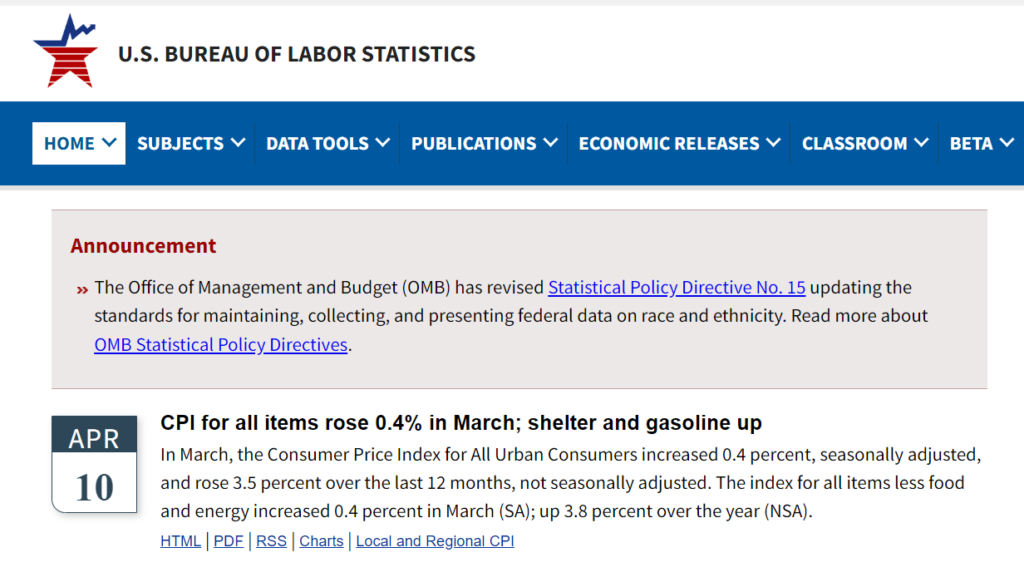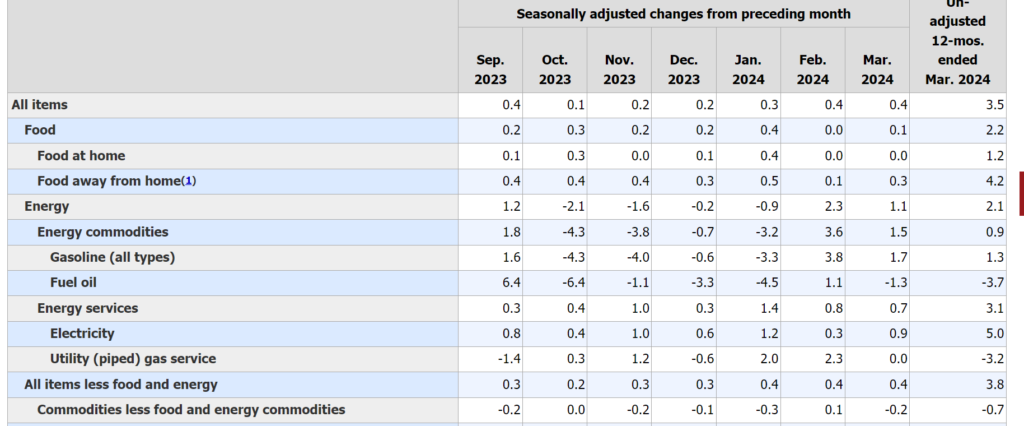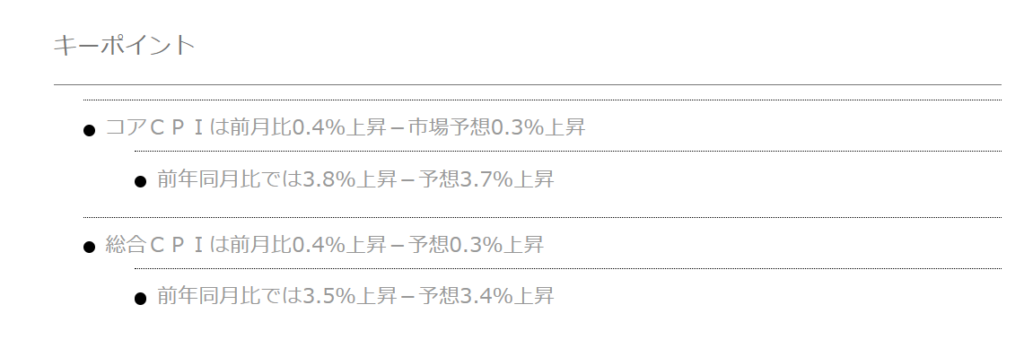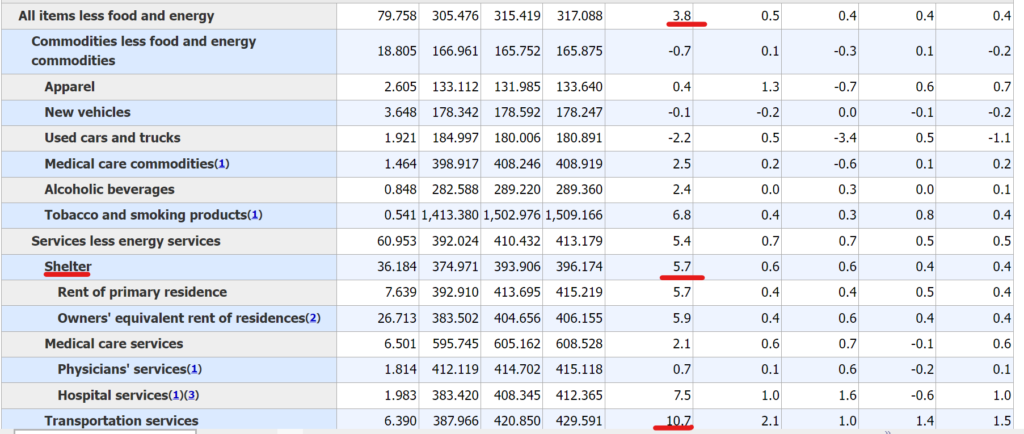Consumer Price Index Summary



Food
The food index increased 0.1 percent in March, while the food at home index was unchanged. Both indexes
were unchanged in February. Three of the six major grocery store food group indexes decreased over the
month while the remaining three had price advances. The index for other food at home decreased 0.5
percent in March, led by a 5.0-percent decline in the index for butter. The cereals and bakery products
index decreased 0.9 percent over the month, the largest 1-month seasonally adjusted decrease ever
reported in that series, which dates to 1989. The index for dairy and related products declined 0.1
percent in March.
The index for meats, poultry, fish, and eggs rose 0.9 percent in March, as the index for eggs rose 4.6
percent over the month. The nonalcoholic beverages index also increased in March, rising 0.3 percent.
The index for fruits and vegetables increased 0.1 percent over the month.
The food away from home index rose 0.3 percent in March, after rising 0.1 percent in February. The
index for limited service meals rose 0.3 percent, and the index for full service meals increased 0.2
percent over the month.
The food at home index rose 1.2 percent over the last 12 months. The index for other food at home rose
1.4 percent over the 12 months ending in March, and the index for fruits and vegetables increased 2.0
percent over the year. The nonalcoholic beverages index increased 2.4 percent over that period. The
index for meats, poultry, fish, and eggs rose 1.3 percent over the 12 months ending in March, and the
index for cereals and bakery products increased 0.2 percent. In comparison, the dairy and related
products index fell 1.9 percent over the year.
The index for food away from home rose 4.2 percent over the last year. The index for limited service
meals rose 5.0 percent over the last 12 months, and the index for full service meals rose 3.2 percent
over the same period.
Energy
The energy index rose 1.1 percent in March, after increasing 2.3 percent in February. The gasoline
index increased 1.7 percent in March. (Before seasonal adjustment, gasoline prices rose 6.4 percent in
March.) The index for electricity rose 0.9 percent in March, while the index for natural gas was
unchanged over the month. The fuel oil index decreased 1.3 percent in March.
The energy index increased 2.1 percent over the past 12 months. The gasoline index rose 1.3 percent,
and the electricity index increased 5.0 percent over this 12-month span. In comparison, the index for
natural gas decreased 3.2 percent over the last 12 months and the index for fuel oil fell 3.7 percent.
All items less food and energy
The index for all items less food and energy rose 0.4 percent in March, as it did the previous 2 months.
The shelter index increased 0.4 percent in March and was the largest factor in the monthly increase in
the index for all items less food and energy. The index for rent rose 0.4 percent over the month, as
did the index for owners' equivalent rent. The lodging away from home index increased 0.1 percent in
March, as it did in February.
The motor vehicle insurance index rose 2.6 percent in March, following a 0.9-percent increase in
February. The index for apparel increased 0.7 percent over the month. Among other indexes that rose in
March were personal care, education, and household furnishings and operations.
The medical care index rose 0.5 percent in March after being unchanged in February. The index for
hospital services rose 1.0 percent over the month and the index for physicians' services increased 0.1
percent. The prescription drugs index rose 0.3 percent in March.
The index for used cars and trucks fell 1.1 percent in March, following a 0.5-percent increase in
February. Over the month, the recreation index fell 0.1 percent over the month, the new vehicles index
decreased 0.2 percent, and the airline fares index declined 0.4 percent.
The index for all items less food and energy rose 3.8 percent over the past 12 months. The shelter
index increased 5.7 percent over the last year, accounting for over sixty percent of the total 12-month
increase in the all items less food and energy index. Other indexes with notable increases over the
last year include motor vehicle insurance (+22.2 percent), medical care (+2.2 percent), recreation
(+1.8 percent), and personal care (+4.2 percent).
Not seasonally adjusted CPI measures
The Consumer Price Index for All Urban Consumers (CPI-U) increased 3.5 percent over the last 12 months
to an index level of 312.332 (1982-84=100). For the month, the index increased 0.6 percent prior to
seasonal adjustment.
The Consumer Price Index for Urban Wage Earners and Clerical Workers (CPI-W) increased 3.5 percent over
the last 12 months to an index level of 306.502 (1982-84=100). For the month, the index increased 0.7
percent prior to seasonal adjustment.
The Chained Consumer Price Index for All Urban Consumers (C-CPI-U) increased 3.4 percent over the last
12 months. For the month, the index increased 0.7 percent on a not seasonally adjusted basis. Please
note that the indexes for the past 10 to 12 months are subject to revision.
_______________
The Consumer Price Index for April 2024 is scheduled to be released on Wednesday, May 15, 2024, at 8:30 a.m. (ET).
Technical Note
Brief Explanation of the CPI
The Consumer Price Index (CPI) measures the change in prices paid by consumers for goods and services.
The CPI reflects spending patterns for each of two population groups: all urban consumers and urban
wage earners and clerical workers. The all urban consumer group represents over 90 percent of the total
U.S. population. It is based on the expenditures of almost all residents of urban or metropolitan areas,
including professionals, the self-employed, the poor, the unemployed, and retired people, as well as
urban wage earners and clerical workers. Not included in the CPI are the spending patterns of people
living in rural nonmetropolitan areas, farming families, people in the Armed Forces, and those in
institutions, such as prisons and mental hospitals. Consumer inflation for all urban consumers is
measured by two indexes, namely, the Consumer Price Index for All Urban Consumers (CPI-U) and the
Chained Consumer Price Index for All Urban Consumers (C-CPI-U). The Consumer Price Index for Urban Wage
Earners and Clerical Workers (CPI-W) is based on the expenditures of households included in the CPI-U
definition that meet two requirements: more than one-half of the household's income must come from
clerical or wage occupations, and at least one of the household's earners must have been employed for
at least 37 weeks during the previous 12 months. The CPI-W population represents approximately 30
percent of the total U.S. population and is a subset of the CPI-U population.
The CPIs are based on prices of food, clothing, shelter, fuels, transportation, doctors' and dentists'
services, drugs, and other goods and services that people buy for day-to-day living. Prices are
collected each month in 75 urban areas across the country from about 6,000 housing units and
approximately 22,000 retail establishments (department stores, supermarkets, hospitals, filling
stations, and other types of stores and service establishments). All taxes directly associated with the
purchase and use of items are included in the index. Prices of fuels and a few other items are obtained
every month in all 75 locations. Prices of most other commodities and services are collected every
month in the three largest geographic areas and every other month in other areas. Prices of most goods
and services are obtained by personal visit, telephone call, web, or app collection by the Bureau's
trained representatives.
In calculating the index, price changes for the various items in each location are aggregated using
weights, which represent their importance in the spending of the appropriate population group. Local
data are then combined to obtain a U.S. city average. For the CPI-U and CPI-W, separate indexes are
also published by size of city, by region of the country, for cross-classifications of regions and
population-size classes, and for 23 selected local areas. Area indexes do not measure differences in
the level of prices among cities; they only measure the average change in prices for each area since
the base period. For the C-CPI-U, data are issued only at the national level. The CPI-U and CPI-W are
considered final when released, but the C-CPI-U is issued in preliminary form and subject to three
subsequent quarterly revisions.
The index measures price change from a designed reference date. For most of the CPI-U and the CPI-W,
the reference base is 1982-84 equals 100. The reference base for the C-CPI-U is December 1999 equals
100. An increase of 7 percent from the reference base, for example, is shown as 107.000. Alternatively,
that relationship can also be expressed as the price of a base period market basket of goods and
services rising from $100 to $107.
Sampling Error in the CPI
The CPI is a statistical estimate that is subject to sampling error because it is based upon a sample
of retail prices and not the complete universe of all prices. BLS calculates and publishes estimates
of the 1-month, 2-month, 6-month, and 12-month percent change standard errors annually for the CPI-U.
These standard error estimates can be used to construct confidence intervals for hypothesis testing.
For example, the estimated standard error of the 1-month percent change is 0.03 percent for the U.S.
all items CPI. This means that if we repeatedly sample from the universe of all retail prices using
the same methodology, and estimate a percentage change for each sample, then 95 percent of these
estimates will be within 0.06 percent of the 1-month percentage change based on all retail prices. For
example, for a 1-month change of 0.2 percent in the all items CPI-U, we are 95 percent confident that
the actual percent change based on all retail prices would fall between 0.14 and 0.26 percent. For the
latest data, including information on how to use the estimates of standard error,
see www.bls.gov/cpi/tables/variance-estimates/home.htm.
Calculating Index Changes
Movements of the indexes from 1 month to another are usually expressed as percent changes rather than
changes in index points, because index point changes are affected by the level of the index in relation
to its base period, while percent changes are not. The following table shows an example of using index
values to calculate percent changes:
Item A Item B Item C
Year I 112.500 225.000 110.000
Year II 121.500 243.000 128.000
Change in index points 9.000 18.000 18.000
Percent change 9.0/112.500 x 100 = 8.0 18.0/225.000 x 100 = 8.0 18.0/110.000 x 100 = 16.4
Use of Seasonally Adjusted and Unadjusted Data
The Consumer Price Index (CPI) program produces both unadjusted and seasonally adjusted data.
Seasonally adjusted data are computed using seasonal factors derived by the X-13ARIMA-SEATS seasonal
adjustment method. These factors are updated each February, and the new factors are used to revise the
previous 5 years of seasonally adjusted data. The factors are available at
www.bls.gov/cpi/tables/seasonal-adjustment/seasonal-factors-2024.xlsx. For more information on data
revision scheduling, please see the Factsheet on Seasonal Adjustment at
www.bls.gov/cpi/seasonal-adjustment/questions-and-answers.htm and the Timeline of Seasonal Adjustment
Methodological Changes at www.bls.gov/cpi/seasonal-adjustment/timeline-seasonal-adjustment-methodology-changes.htm.
How to Use Seasonally Adjusted and Unadjusted Data
For analyzing short-term price trends in the economy, seasonally adjusted changes are usually preferred
since they eliminate the effect of changes that normally occur at the same time and in about the same
magnitude every year-such as price movements resulting from weather events, production cycles, model
changeovers, holidays, and sales. This allows data users to focus on changes that are not typical for
the time of year.
The unadjusted data are of primary interest to consumers concerned about the prices they actually pay.
Unadjusted data are also used extensively for escalation purposes. Many collective bargaining contract
agreements and pension plans, for example, tie compensation changes to the Consumer Price Index before
adjustment for seasonal variation. BLS advises against the use of seasonally adjusted data in
escalation agreements because seasonally adjusted series are revised annually for five years.
Intervention Analysis
The Bureau of Labor Statistics uses intervention analysis seasonal adjustment (IASA) for some CPI
series. Sometimes extreme values or sharp movements can distort the underlying seasonal pattern of
price change. Intervention analysis seasonal adjustment is a process by which the distortions caused by
such unusual events are estimated and removed from the data prior to calculation of seasonal factors.
The resulting seasonal factors, which more accurately represent the seasonal pattern, are then applied
to the unadjusted data.
For example, this procedure was used for the motor fuel series to offset the effects of the 2009 return
to normal pricing after the worldwide economic downturn in 2008. Retaining this outlier data during
seasonal factor calculation would distort the computation of the seasonal portion of the time series
data for motor fuel, so it was estimated and removed from the data prior to seasonal adjustment.
Following that, seasonal factors were calculated based on this "prior adjusted" data. These seasonal
factors represent a clearer picture of the seasonal pattern in the data. The last step is for motor
fuel seasonal factors to be applied to the unadjusted data.
For the seasonal factors introduced for January 2024, BLS adjusted 46 series using intervention
analysis seasonal adjustment, including selected food and beverage items, motor fuels and vehicles.
Revision of Seasonally Adjusted Indexes
Seasonally adjusted data, including the U.S. city average all items index levels, are subject to
revision for up to 5 years after their original release. Every year, economists in the CPI calculate
new seasonal factors for seasonally adjusted series and apply them to the last 5 years of data.
Seasonally adjusted indexes beyond the last 5 years of data are considered to be final and not subject
to revision. For January 2024, revised seasonal factors and seasonally adjusted indexes for 2019 to
2023 were calculated and published. For series which are directly adjusted using the Census
X-13ARIMA-SEATS seasonal adjustment software, the seasonal factors for 2023 will be applied to data for
2024 to produce the seasonally adjusted 2024 indexes. Series which are indirectly seasonally adjusted
by summing seasonally adjusted component series have seasonal factors which are derived and are
therefore not available in advance.
Determining Seasonal Status
Each year the seasonal status of every series is reevaluated based upon certain statistical criteria.
Using these criteria, BLS economists determine whether a series should change its status from "not
seasonally adjusted" to "seasonally adjusted", or vice versa. If any of the 81 components of the U.S.
city average all items index change their seasonal adjustment status from seasonally adjusted to not
seasonally adjusted, not seasonally adjusted data will be used in the aggregation of the dependent
series for the last 5 years, but the seasonally adjusted indexes before that period will not be changed.
For 2024, 36 of the 81 components of the U.S. city average all items index are not seasonally adjusted.
Contact Information
For additional information about the CPI visit www.bls.gov/cpi or contact the CPI Information and
Analysis Section at 202-691-7000 or cpi_info@bls.gov.
For additional information on seasonal adjustment in the CPI visit www.bls.gov/cpi/seasonal-adjustment/home.htm
If you are deaf, hard of hearing, or have a speech disability, please dial 7-1-1 to access
telecommunications relay services.
米国債利回り急伸、年内利下げ予想わずか2回に-CPI受け
by Bloomberg
10日午前の米金融市場で米国債利回りが急伸し、年初来の高水準に達した。3月の米消費者物価指数(CPI)が市場予想を上回る伸びとなり、年内に3回以上の利下げが実施されることはないとの見方が広がった。
米コアCPI、3カ月連続で上振れ-米利下げ後ずれの可能性 (1)
スワップ契約の金利はより高い金利水準へのリプライスが進み、12月のスワップ契約は約4.85%。現在の実効フェデラルファンド(FF)金利は5.33%。
米コアCPI、3カ月連続で上振れ-米利下げ後ずれの可能性
3月の米消費者物価指数(CPI)統計では、変動の大きい食品とエネルギーを除くコア指数が3カ月連続で市場予想を上回る伸びとなった。インフレ圧力の根強さを示唆しており、今年見込まれている米利下げ開始が後ずれする可能性がある。

エコノミストは、基調的なインフレの指標として、総合CPIよりコア指数を重視している。
この記事の考察
3月のCPIはインフレ再燃のリスクが出てきた。3ヵ月連続で市場予想を上回る結果となった。
これで金利の予想が年内の利下げが2回となった。それよりか、利上げもあるのではないかという予想も出てきた。
これを受けて$円の為替レートは152円を突破して152.45円までになった。

円高方向に賭けていた日本の個人投資家はショートカバーに追われることになるだろう。
円安に賭けていた外国の機関投資家は潤うことになるだろう。
しかし、この急激な円安でも日銀の介入はまだない。


Shelter5.5%,Transportation services(輸送サービス)10.7%この2つの上昇率がコアCPIを押し上げた。




コメント